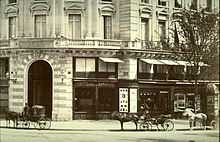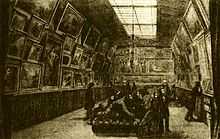Goupil & Cie

Goupil & Cie was a leading art dealership in 19th century France, with headquarters in Paris. Step by step, Goupil established a worldwide trade with fine art reproductions of paintings and sculptures, with a network of branches in London, Brussels, The Hague, Berlin and Vienna, as well as in New York and Australia. Instrumental for this expansion were the Ateliers Photographiques, a plant north of Paris, in Asnières, which took up work in 1869. The leading figure was Adolphe Goupil (1806–1893). His daughter Marie married the French artist Jean-Léon Gérôme.
After various restructurations, Goupil & Cie was formed in 1850; the partners were Adolphe Goupil 1850–1884, Alfred Mainguet 1850–1856, Léon Goupil 1854–1855, Léon Boussod 1856–1884, Vincent van Gogh 1861–1872, Albert Goupil 1872–1884, René Valadon 1878–1884. Until 1861, the firm concentrated on buying, selling and editing prints. To feed an emerging middle-class market for inexpensive art, Goupil's factory outside Paris employed skilled craftsmen to produce engraved, etched, photographic and even sculptural copies of paintings in vast quantities. Goupil's reproductions made Jean-Léon Gérôme, in particular, a well known artist.[1] When Vincent van Gogh (art dealer) (1820–1888),[2] the uncle of painter Vincent van Gogh (who was known as Uncle Cent by Vincent and his brother Theo), entered the firm, the business was expanded to paintings and drawings, finally in 1872 to industrial images, including photographic and héliographic procedures.
Vincent van Gogh fell ill and retired in 1872, but he left his money in the firm until 1878. Albert Goupil, son of Adolphe, took over his duties. When in 1878 the van Gogh shares were finally withdrawn, René Valadon entered the business. From then the firm was completely in the hand of the Goupil family and their sons-in-law Léon Boussod and René Valadon. In 1884, the Goupil family retired, and the firm was again transformed and renamed Boussod, Valadon & Cie, successeurs de Goupil & Cie. Three years later, May 25–27, 1887, the stock of the gallery was sold at auction, "caused by the renewal of the ancient firm Goupil & Cie".
Headquarters and branches

- Paris
- 9 Rue Chaptal (Administration and storerooms)
- Paris
- 19 Boulevard Montmartre
- Originally the place, where Adolphe Goupil started his business, it became a simple saleroom, when the administration was moved to Rue Chaptal. From 1881 this branch was run by Theo van Gogh.
- Paris
- 2 Place de l'Opéra
- Goupil's main sales room displaying Old Masters as well as the contemporary Salon
- New York
- 289 Broadway
- Established in 1846 by Léon Goupil.
- The Hague
- Plaats 14, since 1861 and moved in 1880 to Plaats 20
- Established in the 1830s by Vincent van Gogh on Spuistraat, the gallery was transferred to Plaats 14, in 1861, when fusioned with Goupil
- Brussels
- 58 Rue Montagne de la Cour / Hofberg 58
- Established in 1865 by H. W. van Gogh; after his retirement this branch was run by V. Schmidt.
- London
- Established by Ernest Gambart. 17 Southampton Street. Moved to 25 Bedford Street, Strand in 1875 when Goupil & Cie took over Holloway & Sons and their salerooms.[3] Goupil's manager in London was at this time Charles Obach.
- Berlin
- Charlottenstrasse 63
- Vienna[citation needed]
- Australia[citation needed]
Manzi & Joyant
Manzi, an old friend of Degas as well as a highly skilled printer, and Maurice Joyant, originally Theo van Gogh's successor at 19 Boulevard Montmartre, joined forces, when Boussod & Valadon gave up their business.
Goupil and Van Gogh
"Uncle Cent", as he was called by his nephews, moved to Paris in 1858 and took residence at 9 Rue Chaptal, which housed Goupil's head quarters, too. In 1861, he became partner of Goupil & Cie, but retired in 1872, due to his degrading health, to settle in Princenhage for the summers and in Menton for the winters. Six years later, he withdrew his shares.
As Uncle Cent had no children, his nephews were evidently supposed to follow him up in the firm: Vincent entered in 1869, Theo in 1873. When Vincent was sacked by Léon Boussod in 1876, the balance between the shareholders suffered - and so Theo got his chance. Called to the Paris office for the time of the World Fair 1878, he was offered to stay in Paris. Between 1881 and 1890, Theo was manager of Goupil & Cie's branch on Boulevard Montmartre, from which he sold about 1,000 paintings, including works by members of the Barbizon School like Corot and Daubigny.[4]
In these years, Vincent took up his vocation and began to study art, based on the Cours de dessin, compiled by Charles Bargue "in collaboration with J.-L. Gérôme" and edited by Goupil & Cie, 1868–1873. In 1880, he asked his former director Herman Gijsbert Tersteeg, at Goupil's in The Hague, to lend him a copy, which he finally received with the support of his brother Theo.
See also
References
- ↑ Ken Johnson, (April 20, 2001), A Return to the Junction Of Art and Commerce New York Times.
- ↑
- ↑ Martin Bailey, Van Gogh in England, Barbican Art Gallery, London 1992, p. 11
- ↑ Judith H. Dobrzynski, (June 13, 1999), ART REVIEW; A Return to the Junction Of Art and Commerce New York Times.
Further reading
- John Rewald, Theo van Gogh, Goupil, and the Impressionists, Gazette des Beaux-Arts, January & February 1973, p. 1-107
- Chris Stolwijk & Richard Thompson, ed. Theo van Gogh (1857–1891), Art dealer, collector and brother of Vincent. Waanders, Zwolle 1999. ISBN 90-400-9359-8
- Gérôme & Goupil: Art and Enterprise, Réunion de musées nationaux, Paris 2000 ISBN 2-7118-4152-9
External links
| Wikimedia Commons has media related to Goupil & Cie. |
- Musée Goupil, Bordeaux
- Goupil & Cie and Boussod, Valadon & Co. Records, 1846–1919. Research Library at the Getty Research Institute. Los Angeles, California.
- Goupil & Cie/Boussod, Valadon & Cie Stock Books. Getty Provenance Index at the Getty Research Institute. Los Angeles, California.
- http://www.britishmuseum.org/research/search_the_collection_database/term_details.aspx?bioId=123112